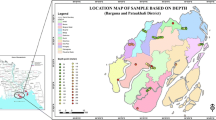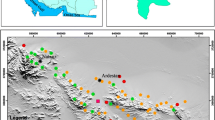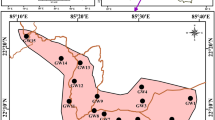Abstract
The present study integrates groundwater hydrochemistry to assess groundwater quality under expanding agricultural activities in Kharga Oasis, Egypt using field data, GIS technique and the multivariate statistical analysis (Factor analysis). A total of 144 groundwater samples were collected and analyzed for major ions and trace elements and the spatial distribution of physicochemical parameters was visualized with GIS. The result has been used to evaluate the groundwater quality in the area for drinking and irrigation purposes comparing with the World Health Organization WHO and Egyptian water standards (EHCW). Results revealed that 93.8% of the groundwater samples are freshwater with TDS \(<\) 1000 mg/l, whereas the rest 6.2% are slightly saline (TDS 1000–3000 mg/l). 35.4% of the groundwater samples are unsuitable for domestic purposes due to the high level of hardness. The calculated water quality index WQI indicates that 88.2% of the samples are excellent for drinking use. Salinity hazard, sodium percent (Na %), sodium adsorption ratio (SAR), residual sodium carbonate (RSC), magnesium hazard (MH), Kelly’s ratio (KR), and soluble sodium percentage (SSP) were calculated to evaluate groundwater quality for irrigation purposes. According to the SSP values, 46% of the samples are good quality water for irrigation purpose, 71% of the samples are good to permissible for irrigation based on Na%, 79.2% of the samples are good for irrigation based on PI values and 91.1% of the samples are suitable for irrigation based on MH values. Based on the above results, most of the collected samples in the Kharga Oasis are unsuitable for drinking and agriculture under ordinary conditions without treatment while it is suitable for many industrial purposes. The factor analysis produced three factors which described 83.13% of the total variance. The results show that the concentrations of pH and HCO3− do not contribute to other chemical parameters. This study demonstrated that the hydrochemical analysis and GIS with statistical factor loading could deliver an influential tool to distinguish factors controlling the groundwater quality in Kharga Oasis area.
Access this chapter
Tax calculation will be finalised at checkout
Purchases are for personal use only
Similar content being viewed by others
References
Abdalla F, Al-Turki A, Amri AA (2015) Evaluation of groundwater resources in the Southern Tihama Plain, Saudi Arabia. Arab J Geosci 8:3299–3310. https://doi.org/10.1007/s12517-014-1401-3
UNESCO (2007) Water portal newsletter no. 161: water-related diseases. http://www.unesco.org/water/news/newsletter/161.shtml
Bacha AA, Durrani MI, Paracha PI (2010) Physical and bacteriological characteristics of drinking water of Peshawar. Pak J Nutr 9:1028–1033
Yesilnacar MI, Gulluoglu MS (2007) The effects of the largest irrigation of gap project on groundwater quality, Sanliurfa–Harran plain, Turkey. Fresenius Environ Bull 16(2):206–211
Yesilnacar MI, Gulluoglu MS (2008) Hydrochemical characteristics and the effects of irrigation on groundwater quality in Harran Plain, GAP Project, Turkey. Environ Geol 54:183–196
Nalbantis I, Tsakiris G (2009) Assessment of hydrological drought revisited. Water Resour Manag 23:881–897
Nagaraju A, Kumar SK, Thejaswi A, Sharifi Z (2014) Statistical analysis of the hydrogeochemical evolution of groundwater in the Rangampeta area, Chittoor district, Andhra Pradesh, South India. Am J Water Res 2:63–70
Raju NJ, Ram P, Dey SJ (2009) Groundwater quality in the lower Varuna river basin, Varanasi district, Uttar Pradesh. Geol Soc India 73:178. https://doi.org/10.1007/s12594-009-0074-0
Vijay R, Samal DR, Mohapatra PK (2011) GIS based identification and assessment of groundwater quality potential zones in Puri city, India. J Water Resour Prot 3:440–447. https://doi.org/10.4236/jwarp.2011.36054
Krishnaraj S, Kumar S, Elango KP (2015) Spatial analysis of groundwater quality using geographic information system—a case study. IOSR 9:01–06
Arulbalaji P, Gurugnanam B (2016) Groundwater quality assessment using geospatial and statistical tools in Salem District, Tamil Nadu, India. Appl Water Sci 7 (6):2737–2751. https://doi.org/10.1007/s13201-016-0501-5
Armanuos AM, Negm A, Saavedra Valeriano OC (2016) Groundwater quality investigation using multivariate analysis-case study: Western Nile Delta Aquifer, Egypt. Inter J Environ Sci Devlop 7:1–9. https://doi.org/10.7763/IJESD.2016.V7.732
Negm AM, Armanuos AM (2016) GIS-based spatial distribution of groundwater quality in the western Nile delta, Egypt. In: Negm AM (ed) The Nile delta. The handbook of environmental chemistry. Springer. https://doi.org/10.1007/698_2016_66
El-Rawy M, Ismail E, Abdalla O (2019) Assessment of groundwater quality using GIS, hydrogeochemistry and factor statistical analysis in Qena governorate, Egypt. Desalin Water Treat 1–16. https://doi.org/10.5004/dwt.2019.24423
Fathi H, El-Rawy M (2018) GIS-based evaluation of water quality index for groundwater resources nearby wastewater treatment plants, Egypt. Poll Res 37:105–116
Ismail E, El-Rawy M (2018) Assessment of groundwater quality in West Sohag, Egypt. Desalin Water Treat 123:101–108. https://doi.org/10.5004/dwt.2018.22687
Liu CW, Lin KH, Kuo YM (2003) Application of factor analysis in the assessment of groundwater quality in a blackfoot disease area in Taiwan. Sci Total Environ 313:77–89
Love D, Hallbauer D, Amos A, Hranova R (2004) Factor analysis as a tool in groundwater quality management: two southern African case studies. Phys Chem Earth 29:1135–1143
Yu S, Shang J, Zhao J, Guo H (2005) Factor analysis and dynamics of water quality of the Songhua River Northeast China. Water Air Soil Pollut 144:159–169
Gao C, Yan J, Yang S, Tan G (2011) Applying factor analysis to water quality assessment: a study case of Wenyu River. In: Li S (ed) Nonlinear mathematics for uncertainty and its applications, AISC 100, pp 541–547
Abdalla O, Al-Abri RY (2014) Factors affecting groundwater chemistry in regional arid basins of variable lithology: example of Wadi Umairy, Oman. Arab J Geosci 7:2861–2870. https://doi.org/10.1007/s12517-013-0981-7
Kudoda AM, Abdalla OAE (2015) Hydrochemical characterization of the main aquifers in Khartoum, the capital city of Sudan. Environ Earth Sci 74:4771–4786. https://doi.org/10.1007/s12665-015-4464-x
Abdelmawgoud A, El-Rawy M, Abu Bakr AM (2021) Evaluating the suitability of groundwater quality for drinking and irrigation purposes in El-Minia governorate, Egypt. J Adv Eng Trends 40(2):21–34. https://journals.ekb.eg/article_128906_dd0e9ad558f7c96ea8a02c0566c153e8.pdf
Awad A, Eldeeb H, El-Rawy M (2020) Assessment of surface and groundwater interaction using field measurements: a case study of Dairut City, Assuit, Egypt. J Eng Sci Technol 15(1):406–425
Klitzsch E (1986) Plate tectonics and cratonal geology in Northeast Africa (Egypt, Sudan). Geologische Rundschau. Int J Earth Sci 75:755. https://doi.org/10.1007/BF01820645
CEDARE (2014) Nubian sandstone aquifer system (NSAS) M&E rapid assessment report. Monitoring & evaluation for water in North Africa (MEWINA) project, water resources management program, CEDARE
El-Rawy M, Abdalla F, El Alfy M (2020) Water resources in Egypt. In: Hamimi Z, El-Barkooky A, Martínez Frías J, Fritz H, Abd El-Rahman Y (eds) The geology of Egypt. Regional geology reviews. Springer, Cham. https://doi.org/10.1007/978-3-030-15265-9_18
Salama RB (1985) Buried troughs, grabens and rifts in Sudan. J Afr Earth Sci 3:381–390
El-Rawy M, De Smedt F (2020) Estimation and mapping of the transmissivity of the Nubian sandstone aquifer in the Kharga Oasis, Egypt. Water 12(2):604. https://doi.org/10.3390/w12020604
APHA (American Public Health Association) (2005) Standard methods for the examination of water and wastewater. In: Eaton AD, Clesceri LS, Greenberg AE (eds) 20th edn. APHA, AWWA, WPCF, New York
WHO (2011) Guidelines for drinking water quality. World Health Organization Geneva, 4th edn. Recommendations, pp 1–4
EHCW (Egyptian higher committee of water) (1995) Egyptian standards for drinking and domestic water according to the act 27/1978 in regulating of the public water supplies, Egypt. Egyptian Governmental Press
ArcGIS 10.3 (2014) ArcMap. Esri software. http://desktop.arcgis.com/en/arcmap/
Aref F, Roosta R (2016) Assessment of groundwater quality and hydrochemical characteristics in Farashband plain. Iran. Arab J Geosci 9:752. https://doi.org/10.1007/s12517-016-2781-3
Hem JD (1985) Study and interpretation of the chemical characteristics of natural water US geological supply paper 2242, p 78
Dudeja SS, Singh NP, Sharma P, Gupta SC, Chandra R., Dhar B, Bansal RK, Brahmaprakash GP, Potdukhe SR, Gundappagol RC, Gaikawad BG, Nagaraj KS (2011) Biofertilizer technology and productivity of chickpea in India. In: Singh A, Parmar N, Kuhad RC (eds) Bioaugmentation, biostimulation and biocontrol. Soil biology. Chapter 28, Springer, Berlin, Heidelberg, pp 43–63
Sawyer CN, McCarty PL (1967) Chemistry for sanitary engineers. McGraw-Hill, New York
Jeevanandam M, Kannan R, Srinivasalu S, Rammohan V (2007) Hydrogeochemistry and groundwater quality assessment of lower part of the Ponnaiyar river basin, Cuddalore district, South India. Environ Monit Assess 132(1–3):263–274
Srinivasamoorthy K, Chidambaram S, Prasanna MV et al (2008) Identification of major sources controlling groundwater chemistry from a hard rock terrain—a case study from Mettur taluk, Salem district, Tamilnadu, India. J Earth System Sci 117(1):49–58
Ayeni AO, Balogun II, Soneye ASO (2011) Seasonal assessment of physico chemical concentration of polluted urban river: case of Ala river in Southwestern Nigeria. Res J Environ Sci 5(1):22–33
Balan N, Liu JY, Otsuak Y, Ram ST, Luhr H (2012) Ionospheric and thermospheric storms at equatorial latitudes observed by CHAMP, ROCSAT and DMSP. J Geophys Res 117: A01313. https://doi.org/10.1029/2011JA016903
Abdalla F, Shamrukh M (2016) Quantification of river Nile/Quaternary aquifer exchanges via riverbank filtration by hydrochemical and biological indicators, Assiut, Egypt. J Earth Syst Sci 25(8):1697–1711. https://doi.org/10.1007/s12040-016-0755-1
Ramakrishnaiah CR, Sadashivaiah C, Ranganna G (2009) Assessment of water quality index for the groundwater in Tumkur Taluk, Karnataka State, India. E J Chem 6(2):523–530
Saeedi M, Abessi O, Sharifi F, Meraji H (2010) Development of groundwater quality index. Environ Monit Assess 163:327–335
Yidana SM, Banoeng-Yakubo B, Akabzaa TM (2010) Analysis of groundwater quality using multivariate and spatial analyses in the Keta basin Ghana. J Afr Earth Sci 58(2):220–234
Vasanthavigar M, Srinivasamoorthy K, Vijayaragavan K, Ganthi RR, Chidambaram S, Anandhan P, Manivannan R, Vasudevan S (2010) Application of water quality index for groundwater quality assessment: Thirumanimuttar Sub-Basin, Tamil Nadu, India. Environ Monit Assess 171:595–609
Tiwari AK, Singh PK, Mahato MK (2014) GIS-based evaluation of water quality index of groundwater resources in West Bokaro coalfield, India. Curr World Environ 9(3):843–850
Richards LA (1954) Diagnosis and improvement of saline and alkali soils: agriculture hand book 60. US Department of Agriculture, Washington, DC, p 160
Mills B (2003) Interpreting water analysis for crop and pasture, File No. FS0334. DPI’S Agency for food and fiber sciences, Toowoomba
Singh V, Khare MC (2008) Groundwater quality evalution for irrigation purpose in some areas of Bhind, Madhya Pradesh (INDIA). J Environ Res Develop 2(3):347–356.
Todd DK (1980) Groundwater hydrology, Wiley, New York, p 535
Domenico PA, Schwartz FW (1990) Physical and chemical hydrogeology. Wiley, New York
Karanth KR (1987) Ground water assessment development and management. McGraw Hill Publishing Company Ltd, New Delhi
Raghunath IIM (1987) Groundwater, 2nd edn. Wiley Eastern Ltd, New Delhi, India, pp 344–369
Doneen LD (1964) Water quality for agriculture. Department of irrigation, University of California, Davis, p 48
Kelly WP (1951) Alkali soils—their formation properties and reclamation. Reinhold Pub, New York
Szabolcs I, Darab C (1964) The influence of irrigation water of high sodium carbonate content of soils. In: Proceedings of 8th international congress of ISSS, vol 2, pp 803–812
Wilkes University Center of Environmental Quality, Geoenvironmental Science and Engineering Department (2002) Corrosion, saturation index, balanced water in drinking water systems—source and cause of corrosion
National Academy of Science (1972) Water quality criteria; protection agency, Washington DC, pp 1–594
Acknowledgements
The authors are thankful to the General Directorate of Groundwater in Al-Kharga and to the Ministry of Water Resources and Irrigation, Egypt, for providing access to the data.
Also, Abdelazim Negm want to acknowledge the support of the Science, Technology and Innovation, Funding Authority (STIFA) of Egypt in the framework of the grant no. 30771 for the project titled “A Novel Standalone Solar-Driven Agriculture Greenhouse—Desalination System: That Grows Its Energy and Irrigation Water” via the Newton-Mosharafa funding scheme, Call 4.
Author information
Authors and Affiliations
Corresponding author
Editor information
Editors and Affiliations
Rights and permissions
Copyright information
© 2021 Springer Nature Switzerland AG
About this chapter
Cite this chapter
El-Rawy, M., Abdalla, F., Negm, A.M. (2021). Groundwater Characterization and Quality Assessment in Nubian Sandstone Aquifer, Kharga Oasis, Egypt. In: Negm, A., Elkhouly, A. (eds) Groundwater in Egypt’s Deserts. Springer Water. Springer, Cham. https://doi.org/10.1007/978-3-030-77622-0_8
Download citation
DOI: https://doi.org/10.1007/978-3-030-77622-0_8
Published:
Publisher Name: Springer, Cham
Print ISBN: 978-3-030-77621-3
Online ISBN: 978-3-030-77622-0
eBook Packages: Earth and Environmental ScienceEarth and Environmental Science (R0)




